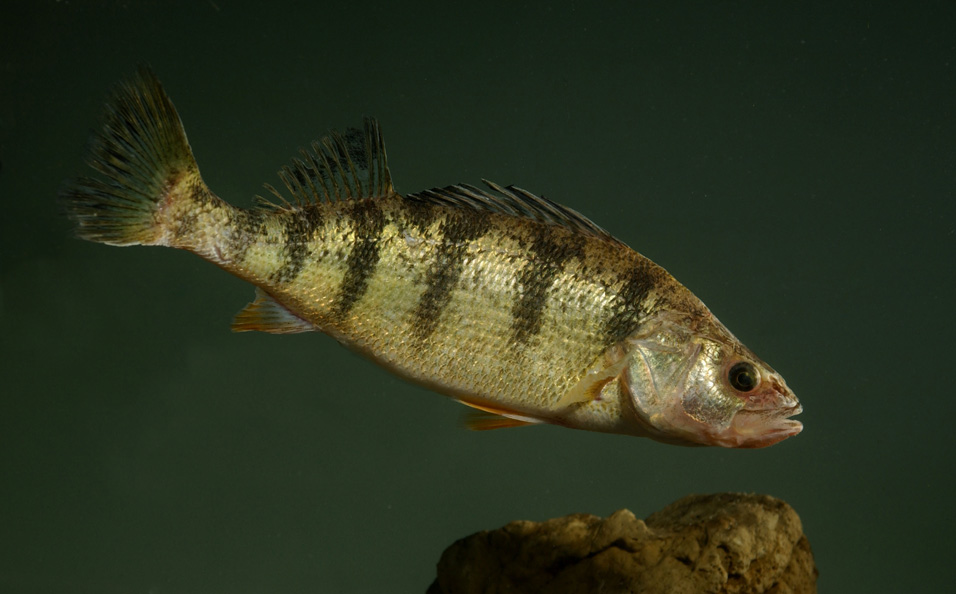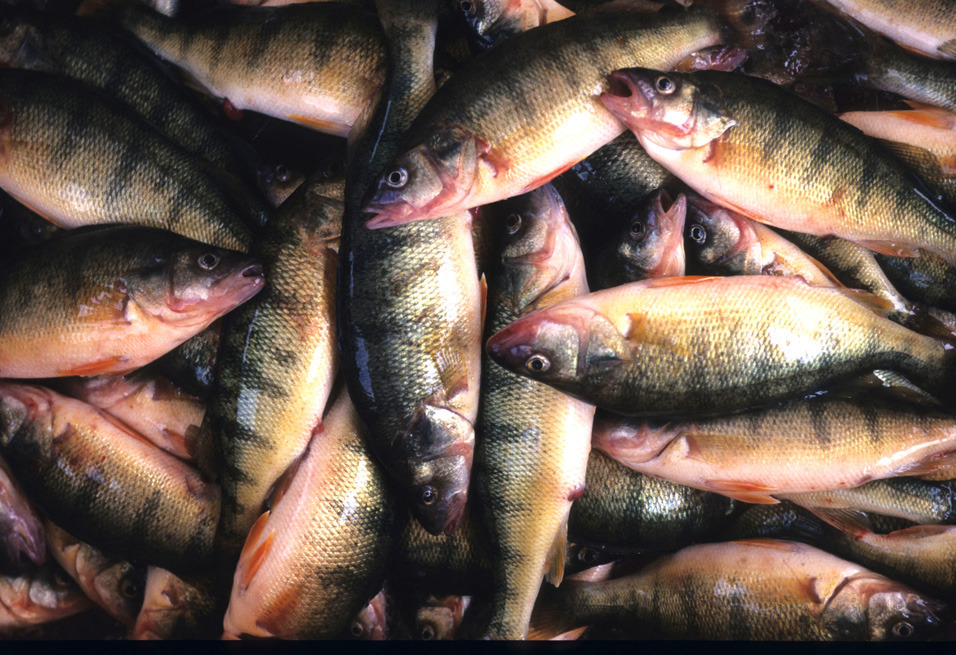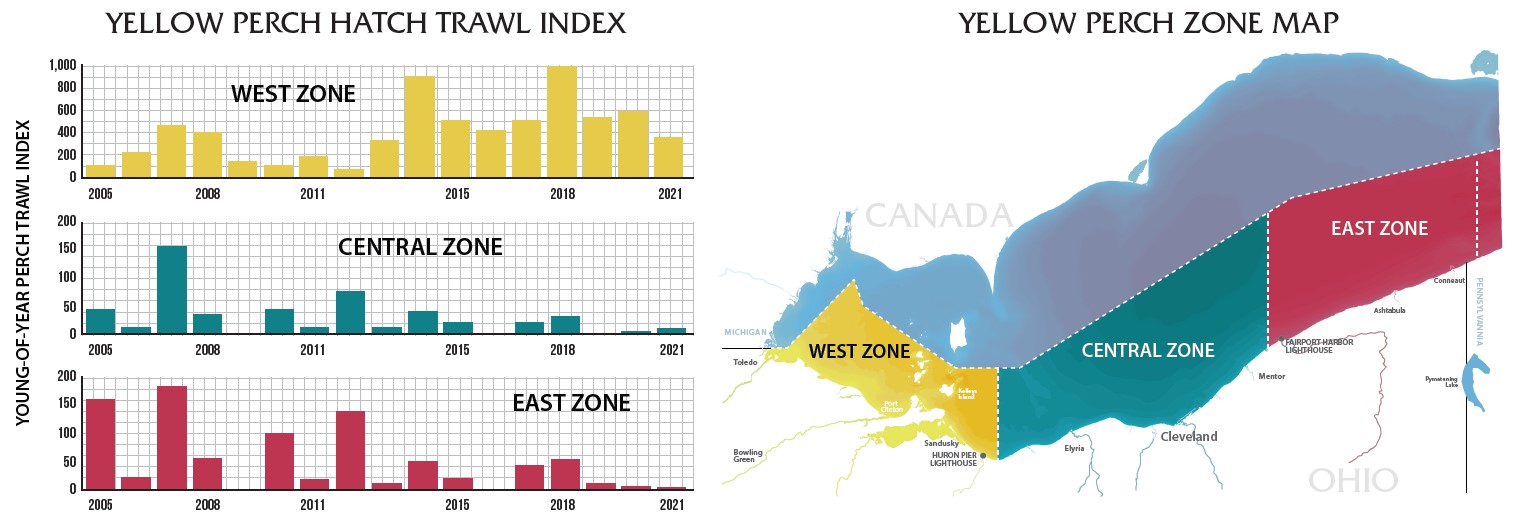
Recently released Ohio Department of Natural Resources yellow perch hatch results indicate more of the same: overall mediocrity, leaning toward the not-so-good side.
That’s the result of an average hatch in the Western Basin and a very poor hatch in the Central Basin from Huron, Ohio, to Conneaut, Ohio.
Results of surveys in Ohio’s Western Basin waters indicate a yellow perch hatch just below the 34-year average, at 380 perch per hectare (about 2.5 acres), according to the ODNR. The average is 398 fish per hectare.
In Ohio, the Central Basin is split into two management zones – the central zone from Huron to Fairport Harbor, Ohio, and the east zone from Fairport Harbor to the Pennsylvania line. Central zone surveys showed 11 fish per hectare, far below the average of 39, and just two fish per hectare in the east zone.
Most fish that hatch each year don’t survive to be counted again, which is shown during the annual ODNR surveys that track fish from the previous year’s hatch.
The 2021 one-year-old fish survey showed about 24 perch per hectare in the Western Basin. But in Ohio’s east and central zones, just 18 and five per hectare were counted, with historic averages being 33 and 29 fish per hectare respectively.
“When you look at history, and we’re fortunate to have a 40-year data set to look at these, there’s rarely ever a good hatch in both basins, the west and the central,” said Travis Hartman, the Lake Erie fisheries program administrator for the ODNR. “Unfortunately for the Central, we’re on a pretty extensive run of poor hatches.”
Yellow perch success is at the whims of Mother Nature
Yellow perch eggs are adhesive, Hartman explained, and laid by the females in one large mass. After being fertilized by males, they essentially just lay on the bottom hoping for the best outcome.
“For a brief time, they have no control over their location, and that’s a case where localized currents can have a huge impact on survival because they can be swept offshore where there’s much less food or swept inshore where there’s going to be more food, more plankton, more structure and rocks,” Hartman said. “So something as simple as the current at the time of hatching could individually determine their fate.”
The problem with yellow perch, he said, is that they don’t time their spawning to conditions. The fish spawn between late April and mid-May, no matter what. If conditions are not favorable, the hatch is likely poor.
Across the border in Pennsylvania, John Hosack described the yellow perch situation as the same. He’s a fisheries biologist with the Pennsylvania Fish and Boat Commission.
“I’d tell you the same thing they’re saying in Ohio, it’s a lack of sufficient recruitment,” he said. “It’s been a long time since we’ve had any substantial recruitment of young-of-year yellow perch, and we just don’t know, we don’t have data to determine what the reasons are.”
According to Hosack, when the walleye fishery in his waters took off around 2015, the perch population began to decline.
“So people have transitioned over almost entirely to walleye,” he said. “It’s almost a complete crash in participation in the yellow perch fishery in the past couple years. The walleye are so easy to catch and you don’t even need specialized gear to catch them.”
Despite the walleye population soaring as the perch population crashed, Hosack hasn’t seen a lot of walleye-on-perch predation. He said there is some, but it’s very limited.
“We don’t get our hands on a lot of sport-caught fish,” he said. “Our primary source is a bait and tackle shop that cleans fish for people, so we collect their fileted fish, and we get a lot of data off those like age and sex and weight and all that stuff. But again, we have some limited data because not a lot of people are engaged in those fisheries.”
New York’s Eastern Basin is the current yellow perch hotspot
Like Ohio and Pennsylvania, New York fisheries managers conduct a series of trawls and other netting activities to survey their fish populations each year. According to Wilkins, a steady string of great yellow perch hatches in New York waters means plenty of catching-size fish will be available for at least the next several years.
“We actually had a very good hatch this year, and we had a catch rate of 2.18 fish per hour this year, that was the best in our 41-year survey,” said Pascal Wilkins, aquatic biologist for the Lake Erie Fisheries Unit for the New York Department of Environment and Conservation. “The average length of those fish is 11.7 inches, also a record for us out here.”
Diet surveys show New York perch are eating plenty of zooplankton and other tiny morsels that can be found on the lake bottom, as well as emerald shiners and other small fish.
A tale of two captains
Operating between Buffalo, New York, and Westfield, New York, Capt. Brent Snyder of Day Five Sportfishing Charter specializes in yellow perch charters and keeps busy getting anglers on the fish.
“I get a lot of charter captains from Ohio that fish with me because they’re trying to figure out if they’re doing something wrong,” he said, going on to explain that Ohio captains are more than capable of catching yellow perch, just not when the fish aren’t there to catch. “You guys just don’t have the forage down there for yellow perch anymore.”
Snyder said he’s spent years dialing in on special techniques for locating and catching yellow perch in New York’s Eastern Basin. Part of his research has included observing the fish as a scuba diver.
“It just happened when my brother-in-law and I would dive, that’s how I started noticing the fish habits,” he said, explaining his techniques are a little bit of a secret, though he guarantees to share all to those who book charters and spend time with Day Five.
For Snyder, a good day of fishing means a limit: 50 fish per angler. Big fish.

A cooler full of fresh-caught yellow perch (Photo Credit: Ohio Department of Natural Resources)
“Most of mine are between 12 and 16 inches,” he said. “When I go out and I find a school of fish and I drop down, if we don’t get a bite in the first three minutes, we’re out of there. I don’t wait around for these fish.”
But in Ohio, limits are often hard to come by.
Capt. Don McGee has been fishing the Western Basin since 1981 and operates King and Eye Charters. While walleye fishing is the main staple, perch trips have historically been an important component of his fishing seasons.
“I normally run about 20 perch charters, and this last year was way down,” he said. “I ran about five, only because I wouldn’t take them. I wanted to be honest with people and just say ‘No.’”
That is, when most people called McGee and asked for a perch trip, he simply explained the situation and politely declined to take them. While it seems like bad business, he said most folks appreciated his outright honesty. The recent decline in Ohio perch numbers and catchability is unfortunate for families with younger kids that like to fish for perch, according to McGee.
“You usually have some sort of action all the time, so it’s a good introduction to understanding how to bait hooks and what depths to find fish at,” he said. “It’s just a really good learning experience for kids.”
Of the five trips he took in 2021, three were good and two were bad, McGee said. And the clients on the not-so-good trips weren’t upset, since they were informed of the yellow perch situation beforehand.
What will fisheries managers do next?
When it comes to managing wild stock fisheries, there aren’t a lot of tools wildlife officials can use outside of adjusting quotas.
“Yellow perch are surveyed and managed as regional populations within management zones,” Hartman explained. “Our surveys during the past few years have shown a marked difference in the yellow perch hatch when comparing the west, central and east zones.”

Image from the Ohio Department of Natural Resources
Creel limits will be adjusted accordingly. For instance, Ohio’s Lake Erie limit in all zones for yellow perch had been 30 for ages. But due to low hatches in Ohio’s zone from Huron to Fairport Harbor, that number fell to a 10-fish limit this summer.
“My expectations are not a lot different for 2022,” Hartman said. “The eastern zone from Fairport Harbor to the Pennsylvania line, obviously we’ll be watching that close and see what the population estimate does but if the quota is low enough, that will drop the limit down there, also.”
Hartman said that due to poor perch fishing in that zone, angling pressure for fish had diminished drastically, even before the 10-fish limit was announced. In addition to creel limits for sport anglers, he said commercial yellow perch harvest quotas can be lowered or even closed, if it’s needed to preserve populations.
Between 2008 and 2015, commercial fishing operations in Ohio’s Western Basin were barred from harvesting yellow perch in six of the eight years due to low populations. Ohio’s quota those years, set by the Great Lakes Fisheries Commission, was reserved solely for sport anglers.
Currently in Lake Erie’s Ohio, Pennsylvania and New York waters, there are no management units closed for commercial yellow perch, though quotas and other rules are subject to change each season. In Ontario waters, commercial walleye netters may keep yellow perch they find in their nets, but do not currently target yellow perch. In Michigan waters of Lake Erie, commercial netters may only target and keep rough fish like suckers, carp, white perch and white bass – no sport fish.
“As much as I’m hoping for that big hatch this spring, there still won’t be an improvement for a few years,” Hartman said. “This isn’t going to change overnight. But the important thing to remember is that many anglers talk as if this is a new scenario and we’ve never been here before. If you look back at the early 90s, the Central Basin was at the same place as right now, so this isn’t new and it’s not drastic.”
It will get better, he said.
“The bottom line is if you want to have some good perch fishing you have to go where it’s good, and right now that means coming to the Western Basin,” Hartman said of Ohio angling. “For five or 10 years, I told people in the west you had to go to the Central Basin. I don’t feel bad saying the reverse right now.”
But Snyder recommends Ohio anglers looking for perch, especially big perch, give up their Ohio dreams in 2022.
“Yes, just call me and book a trip with Day Five,” he said, laughing. “Leave your rods and boat at home and just come on over to New York.”
Catch more news at Great Lakes Now:
I Speak for the Fish: Meeting the mysterious muskie
Walleye Windfall: Lake Erie bait and tackle is big small business
Featured image: A Lake Erie yellow perch (Photo Credit: Ohio Department of Natural Resources)




